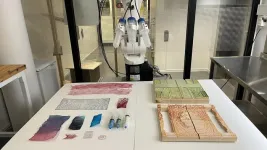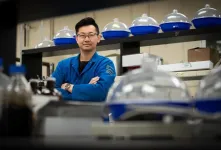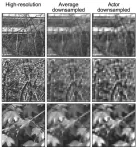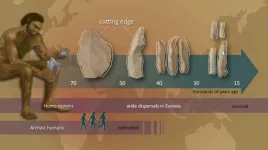From waste to resource: A new and sustainable process transforms sewage sludge into activated carbon
2024-02-07
(Press-News.org)
Sewage sludge is the solid waste resulting from wastewater treatment. According to data from the Ministry for the Ecological Transition and the Demographic Challenge, 1.2 million tons of this waste were produced in Spain in 2021 alone, and its management is a growing problem. Although some of it may have agricultural applications, such as being used as fertilizer after composting, its high concentration of metals limits its use, generating environmental problems.
A new study has managed to give this waste a second life, turning it into activated carbon, a product boasting great added value and of great industrial interest. Due to its high porosity, this compound features a great capacity to adsorb molecules on its surface, which makes it especially useful in decontamination processes, such as water purification and gas treatment.
The project was a joint effort by the Inorganic Chemistry and Waste Bioengineering and Green Engineering groups at the University of Cordoba (UCO). Although this is not the first time that sewage sludge has been transformed into activated carbon, "the study demonstrates the possibility of obtaining this material under more favorable and sustainable conditions, and obtaining a high-quality product," said María Carmen Gutiérrez, one of the authors of the study.
Relative to other similar works published previously, this study has managed to transform the sludge by decreasing the temperature necessary to carry out the process, which means that the waste recovery procedure has lower energy costs, explained Almudena Benítez, another of the project's researchers. The study also managed to reduce the amount of what in the scientific literature is called "activating agent," the substance that activates or accelerates the thermochemical reaction through which the waste becomes a useful product for society.
During the process, after a first stage of drying the sludge, the dried waste is mixed with the activating agent. The compound then undergoes a pyrolysis process (heating to high temperatures, in the absence of oxygen, which carbonizes the residue) and a treatment that purifies and removes certain minerals. "From a practical point of view, it is important to propose solutions that can then be carried out on an industrial scale," said María Ángeles Martín, a professor of Chemical Engineering at the University of Cordoba. In addition to using fewer resources, "it is one of the simplest procedures in the literature, and uses technologies that already exist on the market on an industrial scale," she concluded.
For now the work, originating with the subject of a doctoral thesis by researcher Hansi Martínez, has focused on verifying the quality of the activated carbon that can be obtained from sewage sludge. The next step, the research team explained, is for the group itself to develop applications appropriate for this material.
END
[Attachments] See images for this press release:
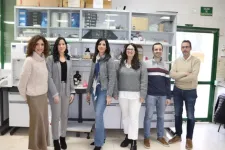

ELSE PRESS RELEASES FROM THIS DATE:
2024-02-07
Although change-oriented behaviors are critical to high quality public service delivery, encouraging employees to embrace and pursue change in the public sector is difficult. Even with sufficient job autonomy–the principal antidote to resistance to change in the public sector literature–public servants may still lack the incentives, skills, information, and sense of security necessary to engage in proactive change-oriented behavior. Consequently, while job autonomy is undoubtedly important, it alone is not enough, as demonstrated by the many cases in which autonomy fails to lead to change and work process improvements. Given the importance of attitudes ...
2024-02-07
For the first time, a hydrogel material made of nanocellulose and algae has been tested as an alternative, greener architectural material. The study, from Chalmers University of Technology in Sweden and the Wallenberg Wood Science Center, shows how the abundant sustainable material can be 3D printed into a wide array of architectural components, using much less energy than conventional construction methods.
The construction industry today consumes 50 percent of the world’s fossil resources, generates 40 percent of global waste and causes 39 percent of global carbon dioxide emissions. There is a growing line of research into biomaterials and their applications, in ...
2024-02-07
When it comes to making fuel from plants, the first step has always been the hardest — breaking down the plant matter. A new study finds that introducing a simple, renewable chemical to the pretreatment step can finally make next-generation biofuel production both cost-effective and carbon neutral.
For biofuels to compete with petroleum, biorefinery operations must be designed to better utilize lignin. Lignin is one of the main components of plant cell walls. It provides plants with greater structural integrity and resiliency from microbial attacks. However, these natural properties of lignin also make it difficult to extract and utilize ...
2024-02-07
The Sun’s polar regions were the most active emitting high energy radiation during the previous solar maximum, an imbalance yet to be explained, and reported for the first time in a study led by a researcher of the Faculty of Sciences of the University of Lisbon (Ciências ULisboa) (Portugal).
The Sun shines brightly in the visible light, but how does it look like at the highest energies of the electromagnetic radiation? The Sun’s picture taken in gamma rays is a deadly sight, luckily blinded by the Earth’s atmosphere and only seen from space. Each photon carries a billion times more energy than its ultraviolet sibling. How does the Sun’s regular gamma rays’ ...
2024-02-07
A major challenge to developing better neural prostheses is sensory encoding: transforming information captured from the environment by sensors into neural signals that can be interpreted by the nervous system. But because the number of electrodes in a prosthesis is limited, this environmental input must be reduced in some way, while still preserving the quality of the data that is transmitted to the brain.
Demetri Psaltis (Optics Lab) and Christophe Moser (Laboratory of Applied Photonics Devices) collaborated with Diego Ghezzi of the Hôpital ophtalmique Jules-Gonin – Fondation Asile des Aveugles (previously Medtronic Chair in Neuroengineering at EPFL) to apply machine ...
2024-02-07
A study led by researchers at the Nagoya University Museum in Japan may change how we understand the cultural evolution of Homo sapiens at the time of their dispersal across Eurasia about 50,000 to 40,000 years ago. These findings challenge traditional beliefs about the timing and nature of cultural transitions during this critical period in human history.
Published in Nature Communications, the researchers’ insights into stone tool technology suggest that the commonly held view of a ‘revolution’ in culture and technology that allowed anatomically modern humans to outcompete ...
2024-02-07
Forests, which cover a third of Earth's land surface, are pivotal in carbon storage and the water cycle, though the full scope of their impact remains to be fully understood. In a new study published in Nature Communications, researchers from Stockholm University and international colleagues provide new insights into the complex role forests play in the climate system and water cycle.
The research, involving scientists from 11 institutions across five countries, including Sweden, the UK, Finland, Germany, and Brazil, highlights the intricate relationship between forests, particularly their emission ...
2024-02-07
Capsaicin, derived from hot chili pepper plants, has been used to treat various types of pain, and a high concentration capsaicin patch (HCCP) is approved for the treatment of nerve (or neuropathic) pain. In a real-world study published in Pain Practice that included 97 outpatients in Germany diagnosed primarily with neuropathic back pain, postoperative/posttraumatic neuropathic pain, or postherpetic neuralgia (shingles pain), patients appeared to benefit from multiple HCCP applications.
Among the ...
2024-02-07
An analysis of relevant published studies indicates that across all ages, food allergy negatively affects individuals’ quality of life to a greater extent in females than in males.
The analysis, which is published in Clinical and Experimental Allergy, included 34 studies. In the studies, women and the parents of girls tended to report a greater impact of food allergy on health-related quality of life than men or parents of boys.
Evidence also showed that improvements in quality of life over the course of treatment for food allergy can be different for males and females, with weak evidence suggesting that male children may experience more improvements ...
2024-02-07
A recent analysis of data from nearly all World Health Organization member states clearly demonstrates a link between air pollution and mortality from cardiovascular diseases, with more of such deaths associated with air pollution in low-income countries compared with high-income countries.
In all 183 countries included in the Chronic Diseases and Translational Medicine study, ischemic heart disease-related deaths attributed to air pollution were higher than stroke-related deaths caused by air pollution. In 2019, outdoor air pollution caused 16 ischemic heart disease-related deaths per 100,000 people in high-income countries compared with 70 per 100,000 in low-income countries.
Also, in ...
LAST 30 PRESS RELEASES:
[Press-News.org] From waste to resource: A new and sustainable process transforms sewage sludge into activated carbon



